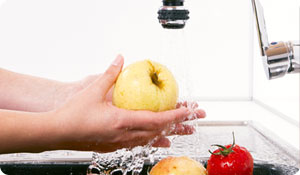
Avoiding food-borne illnesses requires a few basic skills and some common sense about how to shop for, store, and prepare your foods-and how to clean up after yourself.
The basics—Certain rules apply to all foods
- Wash your hands thoroughly with soap and water not only before you handle food, but after touching meat, eggs or dirty fruits and vegetables and of course, after you use the bathroom.
- Wash fruits and vegetables with fresh running water right before you eat them, even foods with a peel and even foods that say "prewashed." Special cleaning solutions aren't necessary.
- Only prepare food using clean utensils, pots and pans, and cutting surfaces. Use hot, soapy water or wash in the dishwasher any knives, bowls, pans, plates, or anything else that touches your food. Disinfect cutting boards with a solution of one-tablespoon chlorine bleach diluted in a gallon of water.
- Never use the same utensils and cooking surfaces for uncooked meats, poultry, and fish on other foods. The uncooked juices from these foods can contaminate other surfaces and spread bacteria.
- Cook all foods to the right temperature. Check out the USDA's Food Safety Education Site for proper thermometer placement, temperatures, and cooking times
- Store foods properly. That means refrigerating or freezing foods perishable foods as soon as possible after purchasing. It also means keeping cold foods cold and hot foods hot. Bacteria can multiply rapidly in lukewarm foods.
The specifics—Certain foods are prime suspects for causing food-borne illnesses. Pay special attention when preparing:
Eggs:
- Buy only from the refrigerated section of a reputable market
- Don't use eggs that are obviously dirty or cracked
- Refrigerate in their original container as soon as possible after purchasing, and don't store them in your refrigerator's egg rack where the temperature may fluctuate every time the door opens.
- Cook eggs until both the yolk and whites are firm. Some experts advise using a thermometer and cooking until the egg is 160 degrees, but according to the USDA, a visual inspection (making sure the egg is cooked) is fine.
- Serve eggs or chill them in the refrigerator as soon as possible after cooking.
- For recipes requiring raw eggs, purchase pasteurized eggs at your market.
Fish:
- The fish at the market should be displayed on a bed of ice.
- Fish eyes should be clear, not cloudy.
- It should smell like the sea, not fishy or sour.
- Gills should be red, and flesh should be firm and springy.
- Fish fillets shouldn't be dark, dry, or discolored.
- Shellfish like clams, oysters, lobsters, and crabs should be sold live. If an open shell doesn't close when you tap it, if a shell is cracked, or if legs don't move, don't buy it.
- Frozen fish should come in sealed packages without any tears or signs it's been crushed.
- Keep fish refrigerated and use within two days.
- Don't refreeze fresh fish that's been thawed.
- Defrost frozen fish overnight in the refrigerator, in cold water or in the microwave until it's pliable, but still slightly frozen.
- Cook fish to 145 degrees or until fillets are firm, flaky, and opaque.
- Cook shellfish until the shells open. Don't eat clams, oysters, or mussels if the shell doesn't open during cooking.
- Serve hot fish as soon as possible and keep cold fish chilled in the refrigerator or on ice for as little time as possible.
Meats and Poultry:
- Refrigerate or freeze fresh meats as soon as possible after purchasing.
- "Use by" dates aren't mandated (though some markets include them on packaging), but make sure the meat you purchase smells fresh, not sour or spoiled.
- Use fresh meats (or freeze) within a day or two of purchasing.
- Thaw meats overnight in the refrigerator, in cold water, or in the microwave until they're pliable, but still slightly frozen.
- You don't have to wash meats before cooking and in fact, this can lead to cross contamination.
- Most meat needs to be cooked to at least 165 degrees. Check out the USDA food safety site for specific temperatures and cooking times.





